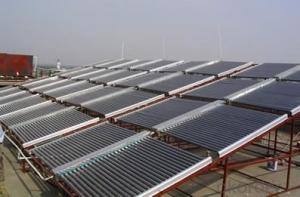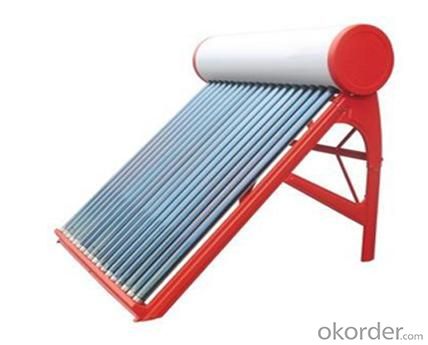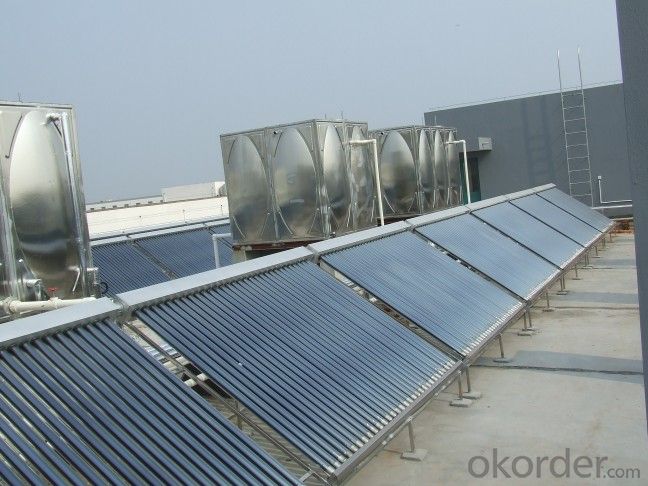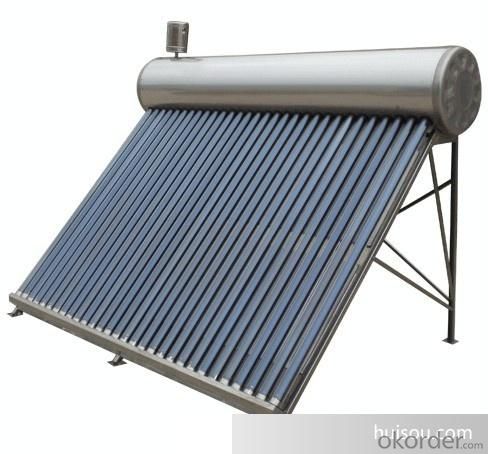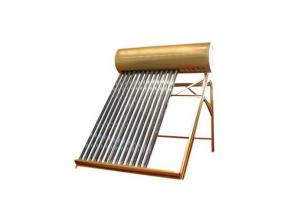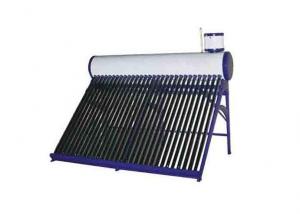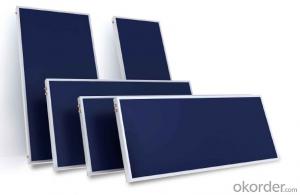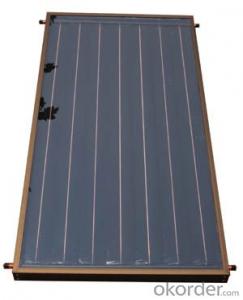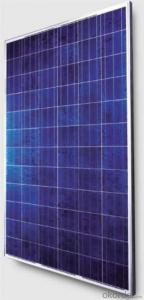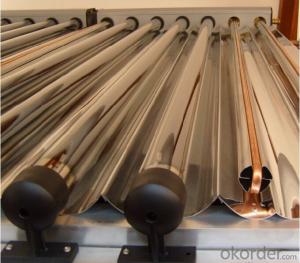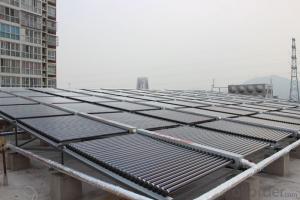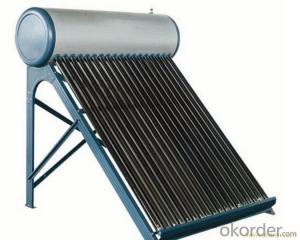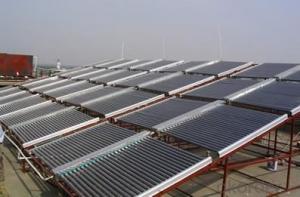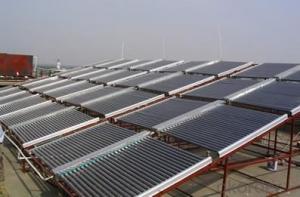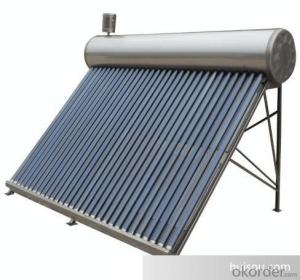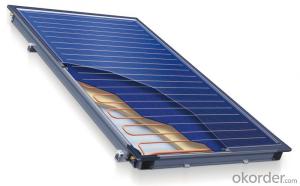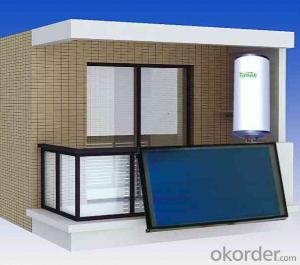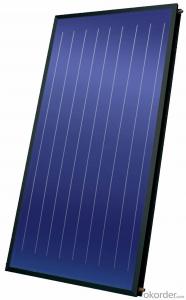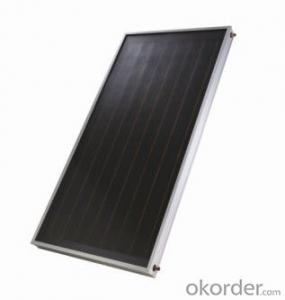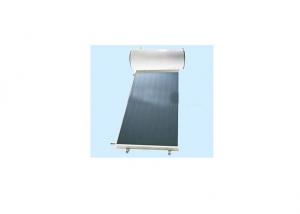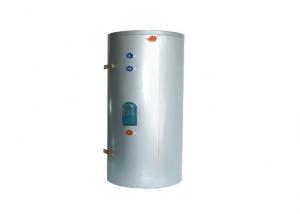Vacuum Solar Collectors Non-Pressurized Heat Pipe Solar Water Heater System 2024 New Design
- Loading Port:
- China main port
- Payment Terms:
- TT OR LC
- Min Order Qty:
- 1 set
- Supply Capability:
- 6000 set/month
OKorder Service Pledge
OKorder Financial Service
You Might Also Like
Introduction of Non-Pressure Solar Water Heater:
Non-pressure Solar Heater is one of the most economical solar water heating device with pretty high efficiency at the same time. It consists of hot water storage tank, solar vacuum tubes with mouth plug in storage tank, and bracket supporting tank and tubes.When cold water in evacuated tubes is heated with solar irradiation, as the specific gravities of hot water and cold water are different, hotter water goes upward to storage tank and colder water goes downward to glass tubes. through this continuous circulation, the cold water in storage tank will be gradually heated till sunset.
Specialty:
1. High thermal performance and working temperature: the heat exchanging rate even in winter can up above 55%.
2. Heat collecting efficiency is at least 20% above common solar systems.
3. Work in all day and all season: no matter any corner of the world, this system can work well even -40℃ to avoid the tube freezing problem.
4. Reliability: No water following through the tube, so water scale can not generate and tube cracks could be avoided, the system still can keep working even with some damaged tubes.
5. It can connect with water tap and work automatically with pressure0.6Mpa, bring enjoyable washing experience.
6. Safety: P/T valve would release pressure and temperature to protect tank..
Technical Specification:
1. Outer tank material: SUS304 stainless steel or powder coated color steel
2. Inner tank material: 1.2mm thick SUS304 food grade stainless steel ( Optional material SUS316L)
3. Vacuum tube material: borosilicate glass 3.3; AL-SS-CU absorb coating, with copper heat pipe inside
4. Frame material: 1.2mm thickness stainless steel
5. Insulation material: 55mm thickness polyurethane
6. Suitable for mains pressure water(up to 8 bar/116psi)
7. Easy plug-in installation
8. Install the T/P valve on the pressurized tank
9. Seal material: Stabilized High Temperature Silicon
Outer tank material: SUS304 stainless steel or powder coated color steel
Inner tank material: 1.2mm thick SUS304 food grade stainless steel ( Optional material SUS316L)
Vacuum tube material: borosilicate glass 3.3; AL-SS-CU absorb coating, with copper heat pipe inside
Frame material: 1.2mm thickness stainless steel
Insulation material: 55mm thickness polyurethane
Suitable for mains pressure water(up to 8 bar/116psi)
Easy plug-in installation
Install the T/P valve on the pressurized tank
Seal material: Stabilized High Temperature Silicon
19. Vacuum Tube | 20. Size (mm) | 21. Φ47*1500 / Φ58*1800 / Φ70*2100 | |||||
22. Tube (pcs) | 23. 10 / 12 / 15 / 18 / 20 / 22 / 24 / 30 / 36 / 42 | ||||||
24. Material | 25. Borosilicate 3.3 glass, magnetron spluttering selective coating | ||||||
26. Coating | 27. Single-target AL-N/AL or Three-target AL/N-Cu-SS | ||||||
28. Water Tank | 29. Capacity | 30. 80L ~ 500L for hot water storage tank | |||||
31. Inner tank | 32. Food-grade stainless steel SUS304-2B / SUS316 | ||||||
33. Insulation | 34. High-density polyurethane foam with 70~80 hour heat preservation | ||||||
35. Tank shell | 36. Food-grade stainless steel SUS304-2B | ||||||
37. Bracket | 38. Shaped strong aluminum alloy structure adaptable for flat or slope roof | ||||||
39. Accessories | 40. Anti-aging silicon seals, Dustproof seals, Air-vent cap, Stainless screws | ||||||
41. Auxiliary Devices | 42. Assistant tank, Intelligent controller, Electrical heater, Magnesium anodes | ||||||
43. Tilt Angle | 44. 25 ~ 50° | ||||||
45. Water Output | 46. 45 - 95°C | ||||||
47. Hail Resistance | 48. Φ25mm diameter | ||||||
49. Model Number | 50. Solar Vacuum Tube | 51. Tank 52. Liter | 53. System 54. Liter | 55. Container Loading Qty /sets | |||
56. Size /mm | 57. Qty /pcs | 58. 20GP | 59. 40GP | 60. 40HQ | |||
61. VNS-58SA12-100 | 62. Φ58*1800 | 63. 12 | 64. 100 | 65. 132 | 66. 58 | 67. 119 | 68. 140 |
69. VNS-58SA15-130 | 70. 15 | 71. 130 | 72. 170 | 73. 54 | 74. 108 | 75. 131 | |
76. VNS-58SA18-150 | 77. 18 | 78. 150 | 79. 198 | 80. 43 | 81. 86 | 82. 105 | |
83. VNS-58SA20-170 | 84. 20 | 85. 170 | 86. 223 | 87. 40 | 88. 80 | 89. 97 | |
VNS-58SA24-200 | 24 | 200 | 263 | 35 | 70 | 85 | |
VNS-58SA30-250 | 30 | 250 | 329 | 28 | 56 | 68 | |
VNS-58SA36-300 | 36 | 300 | 395 | 23 | 47 | 57 | |
Product Show
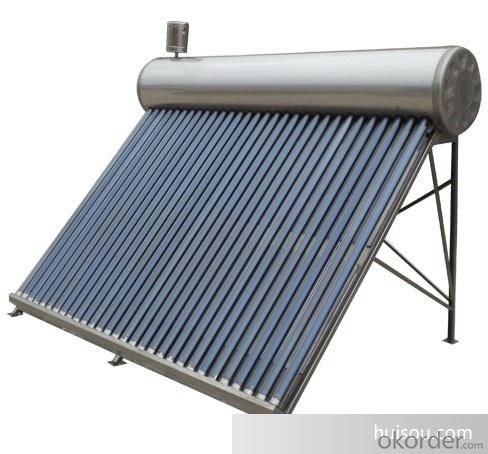
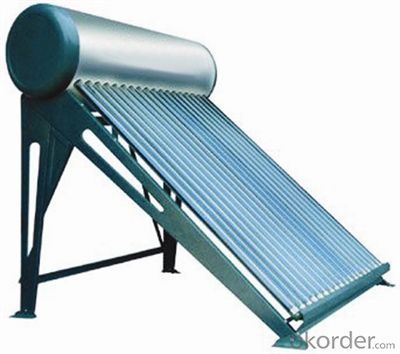
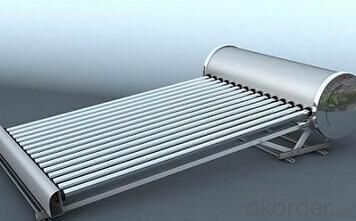
Our Services
1. OEM service
2. Warranty: 5 years
3. Considerable after sale service
Color steel Compact pressure Thermal solar heater
FAQ:
1. What’s the delivery time?
10 days after receiving deposit.
2. How long is the warranty?
5 years for whole system, 1 year for accessory
3. What’s your production capacity?
6000sets/month
4. What’s the MOQ?
1 set.
5. What’s your payment term?
Container: 30% T/T in advance for deposit, 70% T/T before shipment for fist order.
70% T/T after seeing copy of B/L from second order
Sample: 100% T/T in advance
Other choices: L/C at sight.
6. What certifications do you have?
CE, SOLAR KEYMARK, SRCC and etc.
- Q: Can solar collectors be used for heating orchards?
- Yes, solar collectors can be used for heating orchards. Solar thermal systems can capture solar energy and convert it into heat, which can then be used for various purposes, including heating orchards. By utilizing solar collectors, orchard owners can reduce their reliance on fossil fuels and lower heating costs while maintaining optimal growing conditions for their crops.
- Q: Can solar collectors be used for heating water in homes?
- Yes, solar collectors can be used for heating water in homes. Solar water heating systems use solar collectors, also known as solar thermal panels or solar water heaters, to capture the sun's energy and convert it into heat. These collectors are usually installed on the roof or in an open area where they can receive maximum sunlight exposure. The collectors contain tubes through which a heat transfer fluid, such as water or antifreeze, circulates. As the sun's rays hit the collectors, the fluid inside absorbs the heat, which is then transferred to a storage tank or directly to the home's water supply. This heated water can be used for various domestic purposes, including bathing, washing dishes, and doing laundry. Solar water heating systems are an environmentally friendly and cost-effective alternative to traditional water heating methods, as they reduce the reliance on fossil fuels and can significantly lower energy bills.
- Q: Can solar collectors be used for generating electricity on wireless charging stations?
- Wireless charging stations can definitely utilize solar collectors to generate electricity. Solar panels, otherwise called solar collectors, capture sunlight and convert it into electrical energy. This energy can be employed to power diverse devices, including wireless charging stations. By incorporating solar panels onto or near wireless charging stations, the stations can achieve self-sufficiency and operate autonomously without relying on the electrical grid. This is especially advantageous in remote areas where electricity access may be limited or costly. Additionally, it aids in reducing the environmental impact by utilizing renewable energy. The electricity generated by solar collectors can be stored in batteries for use during cloudy days or at night when sunlight is unavailable. This ensures a continuous power supply to the wireless charging stations, enabling them to function effectively and wirelessly charge devices. To conclude, solar collectors can be effectively utilized for generating electricity on wireless charging stations, offering a sustainable and dependable power source.
- Q: Can solar collectors be used in urban areas?
- Yes, solar collectors can be used in urban areas. While space constraints and shading from tall buildings may limit their efficiency, solar collectors can still be installed on rooftops, facades, or in open spaces such as parks and parking lots. Additionally, advancements in technology have led to the development of more compact and efficient solar panels, making them increasingly viable for urban settings.
- Q: What is the impact of altitude on solar collector performance?
- The impact of altitude on solar collector performance is primarily related to the reduction in air density at higher altitudes. This decrease in air density leads to a lower heat transfer coefficient, resulting in reduced heat transfer efficiency of the solar collectors. Additionally, the decrease in atmospheric pressure at higher altitudes can affect the boiling point of the heat transfer fluid, potentially leading to operational challenges. However, the impact of altitude on solar collector performance can vary depending on factors such as the type of collector, location, and design considerations.
- Q: How do solar collectors compare to traditional fossil fuel-based heating systems in terms of emissions?
- When it comes to emissions, solar collectors outperform traditional fossil fuel-based heating systems by a wide margin. The latter, which burn coal, oil, or natural gas, release substantial amounts of greenhouse gases, primarily carbon dioxide (CO2), that contribute to global warming and climate change. On the contrary, solar collectors harness the sun's energy to generate heat without any direct emissions or pollution. By utilizing solar collectors for heating purposes, we can significantly lessen our carbon footprint and alleviate the adverse impact on the environment. Solar energy, being both renewable and clean, ensures that no harmful pollutants are discharged into the atmosphere during its production. This makes solar collectors an indispensable component in transitioning towards a more sustainable and eco-friendly future. Moreover, solar collectors do not necessitate a continuous supply of fuel since they solely rely on the abundant and free energy from the sun. In contrast, fossil fuel-based systems rely on the extraction, transportation, and combustion of fossil fuels, which not only deplete finite resources but also contribute to air pollution and environmental degradation. To summarize, solar collectors surpass traditional fossil fuel-based heating systems in terms of emissions. They provide a sustainable and environmentally friendly alternative that aids in combating climate change, reducing air pollution, and preserving our planet for future generations.
- Q: How do solar collectors affect the resale value of a property?
- Solar collectors can significantly increase the resale value of a property. As they reduce energy costs and provide sustainable energy, they appeal to environmentally conscious buyers. Additionally, solar collectors may qualify homeowners for tax incentives and grants, making the property more attractive to potential buyers.
- Q: Can solar collectors be used in hurricane-prone areas?
- Yes, solar collectors can be used in hurricane-prone areas. However, it is important to design and install them with the specific environmental conditions in mind. Reinforced mounting systems, proper anchoring, and impact-resistant materials can help ensure the durability and safety of solar collectors in hurricane-prone areas. Additionally, regular maintenance and inspections are crucial to identify and address any potential damage or wear caused by high winds or debris.
- Q: Can solar collectors be used for heating radiant wall systems?
- Yes, solar collectors can be used for heating radiant wall systems. Solar collectors capture energy from the sun and convert it into heat, which can then be used to heat water that circulates through the radiant wall system, providing efficient and sustainable heating.
- Q: Can solar collectors be used for generating electricity on tablets?
- Solar collectors, also referred to as solar panels, cannot be utilized directly on tablets to generate electricity. The purpose of solar collectors is to convert sunlight into usable electrical energy. Nonetheless, tablets lack the essential infrastructure to support solar panels and convert the generated electricity into a viable form. Tablets typically depend on rechargeable batteries or power cords to fulfill their energy requirements. Although portable solar chargers exist, capable of generating electricity to charge tablets, they are not integrated into the tablet's design.
Send your message to us
Vacuum Solar Collectors Non-Pressurized Heat Pipe Solar Water Heater System 2024 New Design
- Loading Port:
- China main port
- Payment Terms:
- TT OR LC
- Min Order Qty:
- 1 set
- Supply Capability:
- 6000 set/month
OKorder Service Pledge
OKorder Financial Service
Similar products
Hot products
Hot Searches
Related keywords
